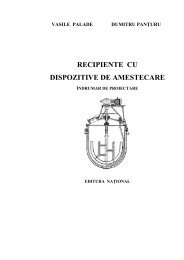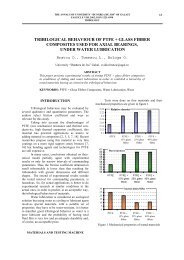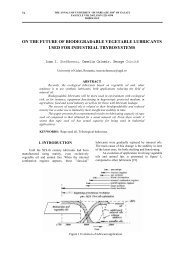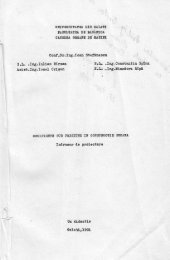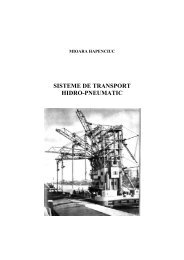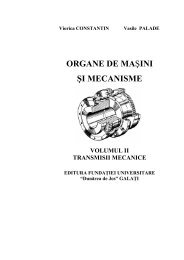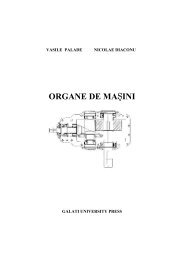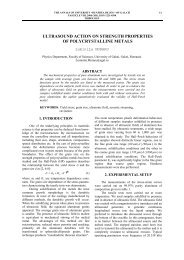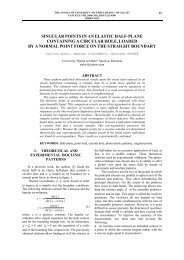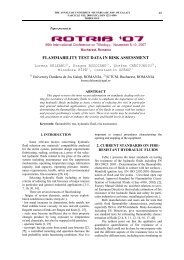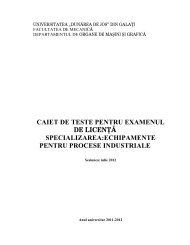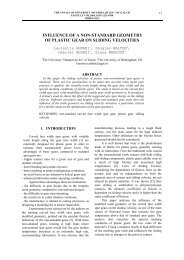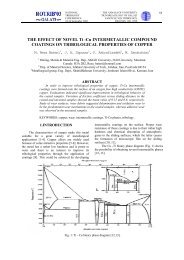Negative pressure in the oil film of journal bearing Dr
Negative pressure in the oil film of journal bearing Dr
Negative pressure in the oil film of journal bearing Dr
Create successful ePaper yourself
Turn your PDF publications into a flip-book with our unique Google optimized e-Paper software.
NATIONAL<br />
TRIBOLOGY<br />
CONFERENCE<br />
24-26 September 2003<br />
THE ANNALS OF UNIVERSITY<br />
“DUNĂREA DE JOS“ OF GALAŢI<br />
FASCICLE VIII, TRIBOLOGY<br />
2003 ISSN 1221-4590<br />
219<br />
Figure 7 shows <strong>the</strong> reduced bear<strong>in</strong>g coefficient<br />
<strong>of</strong> friction µ’= µ/ψ by both <strong>the</strong>ories and <strong>the</strong>ir ratio Z.<br />
The curves show that <strong>the</strong> bear<strong>in</strong>g friction decreases<br />
slightly near ε=0.6, when negative <strong>pressure</strong> is<br />
developed. At larger ε <strong>the</strong> effect reverses.<br />
Figure 8 depicts <strong>the</strong> <strong>journal</strong> centre orbits<br />
calculated by both <strong>the</strong>ories under vertical load. The<br />
orbit is pushed horizontally and towards bear<strong>in</strong>g<br />
clearance circle when negative <strong>pressure</strong> is developed.<br />
This means that <strong>the</strong> <strong>oil</strong>-<strong>film</strong> force becomes more<br />
“unstable”, that is <strong>the</strong> equilibrium <strong>of</strong> a rotor carried<br />
by <strong>journal</strong> bear<strong>in</strong>gs can become more unstable due to<br />
<strong>the</strong> <strong>oil</strong>-<strong>film</strong> force, when negative <strong>pressure</strong> is<br />
developed.<br />
Figure 9 depicts <strong>the</strong> <strong>oil</strong> flow rate Q out <strong>of</strong> both<br />
sides <strong>of</strong> <strong>the</strong> bear<strong>in</strong>g. The <strong>oil</strong> flow rate decreases by<br />
∆Q, when negative <strong>pressure</strong> is developed, because <strong>the</strong><br />
<strong>oil</strong> flowed out <strong>of</strong> <strong>the</strong> bear<strong>in</strong>g sides is sucked aga<strong>in</strong> by<br />
<strong>the</strong> negative <strong>pressure</strong>.<br />
0<br />
-0.2<br />
-0.4<br />
-0.6<br />
-0.8<br />
-1<br />
ε<br />
0 0.2 0.4 0.6 0.8 1<br />
Conventional<br />
<strong>the</strong>ory<br />
Fig.8 Journal orbit<br />
Bubble <strong>the</strong>ory<br />
(MPa)<br />
2<br />
1.5<br />
1<br />
0.5<br />
0<br />
p<br />
Z<br />
Conventional<strong>the</strong>ory<br />
× Bubble <strong>the</strong>ory<br />
Z=Bubble <strong>the</strong>ory/<br />
Conv.<strong>the</strong>ory<br />
ε<br />
0 0.5 1<br />
Fig.6 Load carry<strong>in</strong>g capacity<br />
p<br />
1<br />
Z<br />
0<br />
Q<br />
2<br />
1.5<br />
1<br />
0.5<br />
0<br />
Conventional <strong>the</strong>ory<br />
Bubble <strong>the</strong>ory<br />
0 0.5 1 ε<br />
Fig.9 Fig.9 Oil Oil flow flow rate rate Q<br />
∆Q<br />
µ’=µ/ψ<br />
Z<br />
150<br />
Z<br />
100<br />
1<br />
Convent. <strong>the</strong>ory<br />
50<br />
Bubble <strong>the</strong>ory<br />
0<br />
0<br />
0 0.5 ε 1<br />
Fig.7 Fig.7 Coefficient <strong>of</strong> <strong>of</strong> friction µ’<br />
CONCLUSIONS<br />
In this paper, existence and <strong>in</strong>fluences <strong>of</strong><br />
negative <strong>pressure</strong> are <strong>in</strong>vestigated for <strong>the</strong> <strong>oil</strong>-<strong>film</strong> <strong>of</strong><br />
<strong>journal</strong> bear<strong>in</strong>g with a circumferential <strong>oil</strong> groove. The<br />
results can be summarized as follows.<br />
(1) Existence <strong>of</strong> negative <strong>pressure</strong> could be<br />
verified experimentally <strong>in</strong> <strong>the</strong> <strong>oil</strong>-<strong>film</strong>.<br />
(2) Tak<strong>in</strong>g <strong>in</strong>to consideration <strong>the</strong> surface<br />
dilatational viscosity, <strong>the</strong> negative <strong>pressure</strong> could be<br />
reproduced.<br />
(3) When negative <strong>pressure</strong> is developed <strong>in</strong> <strong>oil</strong><strong>film</strong>,<br />
<strong>the</strong> bear<strong>in</strong>g load capacity <strong>in</strong>creases slightly and<br />
<strong>the</strong> frictional coefficient decreases near ε=0.6. At<br />
larger ε <strong>the</strong>se changes reverse.



